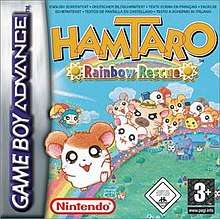Hamtaro: Rainbow Rescue
Hamtaro: Rainbow Rescue[lower-alpha 1] is an adventure video game developed by AlphaDream for Game Boy Advance. It was released by Nintendo in Japan and PAL regions, and was set to be released in North America, but was cancelled. It is based on the Hamtaro series by Ritsuko Kawai.
| Hamtaro: Rainbow Rescue | |
|---|---|
 Cover art | |
| Developer(s) | AlphaDream |
| Publisher(s) | Nintendo |
| Platform(s) | Game Boy Advance |
| Release | |
| Genre(s) | Adventure |
| Mode(s) | Single player |
Gameplay and premise
Hamtaro: Rainbow Rescue stars Hamtaro, Bijou, and other hamsters. Bijou witnesses a rainbow, which disappears as a Prince named Bo falls to the ground. The Prince states that he can make rainbows by using his umbrella, but discovers that his umbrella has lost its power due to losing its colors. Hamtaro goes to collect things of the proper color for Bo to use to power his umbrella and make the rainbow reappear.[1] Certain minigames are needed to reach the colors, and players must have certain Ham-Hams in their party in order to play them. There are more than 100 minigames in Rainbow Rescue.[2]
Development
Hamtaro: Rainbow Rescue was revealed at E3 2003.[3] It was later shown at the 2003 Leipzig Games Convention.[4] It was released on May 23, 2003 in Japan and October 29, 2004 in Europe. The European release was delayed to allow Hamtaro: Ham-Ham Games to coincide with the 2004 Summer Olympics.[5] The European release received limited distribution due to a lack of interest.[5] It had a release date for North American audiences of July 4, 2004.[6] It was delayed to a release date of early 2005.[5] Its American release was eventually cancelled.[7]
Reception
Hamtaro: Rainbow Rescue has received generally positive reception, holding a 77.95% aggregate score on GameRankings.[8] It received an average rating of 30 out of 40 from Famitsu, and was in its Silver Hall of Fame.[9] Nintendo World Report felt that the addition of minigames was a welcome one for the Hamtaro series. They suggested that it and Ham-Ham Games served as good opportunities to test minigame ideas for the Mario & Luigi series.[2][10] Writer Adam Riley found it "surprisingly fun," praising AlphaDream for undertaking a strange concept for a game and for its "bright, bold and pretty" visuals.[5] Jeux Video felt that its design would appeal to people who enjoy cute things. They felt the game would appeal to children well, but also felt that the minigames were too basic.[1]
Notes
- known in Japan as Tottoko Hamtaro 4: Nijiiro Daikoushin Dechu (とっとこハム太郎4 にじいろ大行進でちゅ)
References
- de Romendil, L'avis (November 2, 2004). "Test : Hamtaro : Rainbow Rescue". Jeux Video. Archived from the original on August 21, 2019. Retrieved September 10, 2019.
- Shughart, Ty (May 16, 2003). "Hamtaro: Rainbow Rescue". Nintendo World Report. Retrieved September 10, 2019.
- Harris, Craig (May 13, 2003). "E3 2003: Hamtaro: Rainbow Rescue". IGN. Archived from the original on November 3, 2017. Retrieved September 10, 2019.
- Schneider, Peer (August 21, 2003). "GC 2003: Nintendo Booth Report". IGN. Archived from the original on March 17, 2018. Retrieved September 10, 2019.
- Riley, Adam (December 14, 2004). "Hamtaro: Rainbow Rescue (Game Boy Advance) Review". Cubed3. Archived from the original on June 1, 2019. Retrieved September 10, 2019.
- Harris, Craig (April 1, 2004). "New Dates for Nintendo". IGN. Archived from the original on August 25, 2018. Retrieved September 10, 2019.
- Thomas, Lucas M. (July 6, 2011). "Nintendo's Divided Divisions". IGN. Archived from the original on December 10, 2018. Retrieved September 10, 2019.
- "Hamtaro: Rainbow Rescue". GameRankings. Archived from the original on April 30, 2019. Retrieved September 10, 2019.
- "とっとこハム太郎4 にじいろ大行進でちゅ". Famitsu. Retrieved September 10, 2019.
- Baker, Justin (July 25, 2013). "History of AlphaDream: Ketchup and Plumbers". Nintendo World Report. Archived from the original on March 2, 2019. Retrieved September 10, 2019.